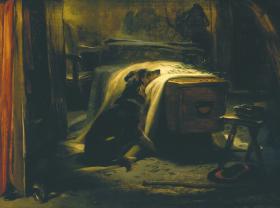Landseer, Edwin Henry. The Monarch of the Glen: Landseer in the Highlands. Exhibition catalogue. Edinburgh: National Galleries of Scotland, 2005
Edwin Landseer
Died: London, 1 October 1873
Nationality: English
son of artist John Landseer
with father; with Benjamin Robert Haydon, Royal Academy Schools (London)
1813 – wins Society of Arts Silver Palette for drawing
1815 – first Royal Academy (RA) exhibition
1826 – elected RA Associate
1831 – becomes full member of RA
1840s – gives etching lessons to Queen Victoria and Prince Albert
1850 – knighted by Queen Victoria
1854 – illustrates Sir Walter Scott’s Waverley novels
1858 – receives commission for four bronze lions for Nelson’s Coumn in Trafalgar Square (in situ, installed 1867)
1865 – declines presidency of RA due to failing health
Travels
Scotland (1824, subsequent visits every autumn)
Victoria (Queen of England)
Hunting of Chevy Chase, 1825–26 (Birmingham Art Gallery, UK)
Dignity and Impudence, 1839 (Tate, London)
Monarch of the Glen, c. 1851 (John Dewar & Sons, London)
Documentation:
Edward Fenton explains the popularity of Landseer in his time:
“Most of the elements of this success are easy to trace. For one thing, Landseer lived at a time when the mercantile middle-class came into emergence as collectors. The great houses of the aristocracy were already full to bursting with accumulated works of art. Their days of patronage were over, since there was no more room for acquisition. Landseer’s works were ideally suited to the tradesmen who now came to the fore, with their large empty new houses that had to be filled. There were not graduates of the Grand Tour and so had little use for the Italian schools. Nor did they want elegant old master portraits of people to whom they were not related. They preferred their contemporaries. Furthermore, pictures like Landseer’s were easy to understand. They told stories, they bore moral messages, they contained pathos, homely sentiment, and character. They faithfully reproduced the textures and scenes which a society lately rural and now turned to manufactures could appreciate.
The wildness of the Scottish landscape and the interpretation of Highland life in which Landseer specialized also made a great appeal to the Victorian sense of the romantic. And, finally, his pictures were respectable.
Respectability was a quality which could not be overestimated. Victoria’s was an era when the high moral character of a work of art was a prime consideration of judgment. ‘Vulgarity’ was the one thing above all others to be eschewed.”
Edward Fenton, “Portrait of a Victorian Painter, with Dogs,” The Metropolitan Museum of Art Bulletin, vol. 10, no. 5 (January 1952): 160.




 Buy the Book
Buy the Book